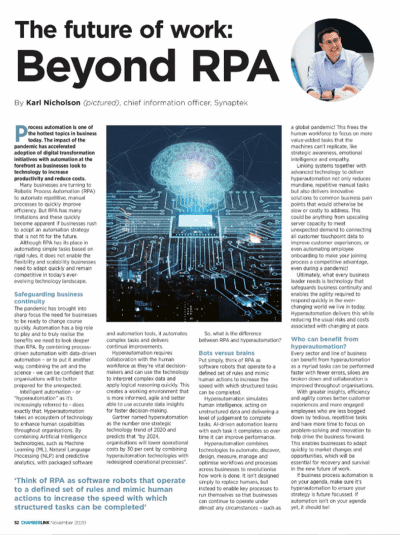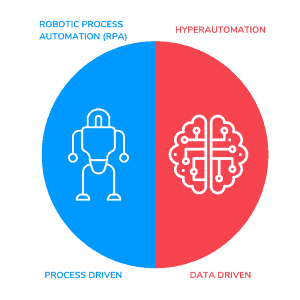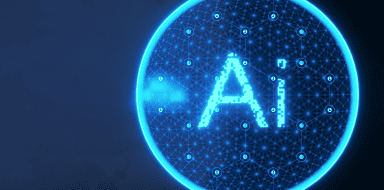Beyond RPA: A hyperautomated future of work
Process automation is one of the hottest topics in business today. The impact of the pandemic has accelerated the adoption of digital transformation initiatives with automation at the forefront. Businesses are turning to technology in order to increase productivity and reduce costs.
Many businesses are turning to Robotic Process Automation (RPA) to automate repetitive, manual processes and quickly improve efficiency. However, RPA has its limitations. They quickly become apparent if businesses rush to adopt an automation strategy that is not fit for the future.
We recently discussed this in an editorial feature in the Birmingham Chamber of Commerce magazine, ChamberLink, available here:

RPA has its place in automating simple tasks based on rigid rules. It doesn’t enable the flexibility and scalability businesses need to adapt quickly and remain competitive in today’s ever-evolving technology landscape.
Watch the CIO of Synaptek, our Digital Innovation Division, deliver an engaging webinar at Birmingham Tech Week on this subject.
Safeguarding business continuity
The pandemic has brought into sharp focus the need for businesses to be ready to change course quickly. Automation has a big role to play and to truly realise the benefits we need to look deeper than RPA. By combining process-driven automation with data-driven automation, we can be confident that organisations will be better prepared for the unexpected.
Intelligent automation – or “hyperautomation” as it’s increasingly referred to – does exactly that. It takes an ecosystem of technology to enhance human capabilities throughout organisations. AI technologies, such as Machine Learning, Natural Language Processing and predictive analytics. Combined together with packaged software and automation tools, it automates complex tasks and delivers continual improvements.
Hyperautomation requires collaboration with the human workforce. They are vital decision-makers and can use the technology to interpret complex data and apply logical reasoning quickly. This creates a working environment that’s more informed, agile and better able to use accurate data insights for faster decision-making.
Gartner named hyperautomation as the number 1 strategic technology trend of 2020. It predicts that “by 2024, organisations will lower operational costs by 30% by combining hyperautomation technologies with redesigned operational processes”.
So, what is the difference between RPA and hyperautomation?

Bots versus brains
Put simply, think of RPA as software robots. They operate to a defined set of rules and mimic human actions increasing the speed structured tasks can be completed.
Hyperautomation simulates human intelligence, acting on unstructured data and delivering a level of judgement to complete tasks. AI-driven automation learns with each task it completes, so over time it can improve performance.
Hyperautomation combines technologies to automate, discover, design, manage and optimise workflows and processes across businesses revolutionising how work is done. It isn’t designed simply to replace humans, but instead to enable key processes to run themselves. This is so businesses can continue to operate under almost any circumstances – such as a global pandemic! This frees up humans to focus time on tasks that machines can’t replicate, like strategic awareness, emotional intelligence and empathy.
Linking systems together with advanced automation technology reduces repetitive, manual tasks and delivers innovative solutions to common business pain points. These pain points could be costly to address without advanced automation. This could be anything, such as: Upscaling server capacity to meet unexpected demand; Connecting all customer touchpoint data to improve customer experiences; Even automating employee onboarding to make your joining process a competitive advantage.
Ultimately, business leaders need technology that safeguards business continuity and enables them to respond quickly in the ever-changing world today. Hyperautomation delivers this while reducing the usual risks and costs associated with changing at pace.
Who can benefit from hyperautomation?
Every sector and line of business can benefit from hyperautomation. Myriad tasks can be performed faster with fewer errors, siloes are broken down and collaboration is improved throughout organisations. With greater insights, efficiency and agility comes better customer experiences. Your employees are more engaged too. This is because they’re less bogged down by tedious, repetitive tasks. Overall, this gives them more time to focus on problem-solving and innovation that will drive the business forward. All of this enables businesses to adapt quickly to market changes and opportunities. A necessity for recovery and survival in the new future of work.
If business process automation is on your agenda, make sure it’s hyperautomation to ensure your strategy is future focussed. If automation isn’t on your agenda yet, it should be!


















